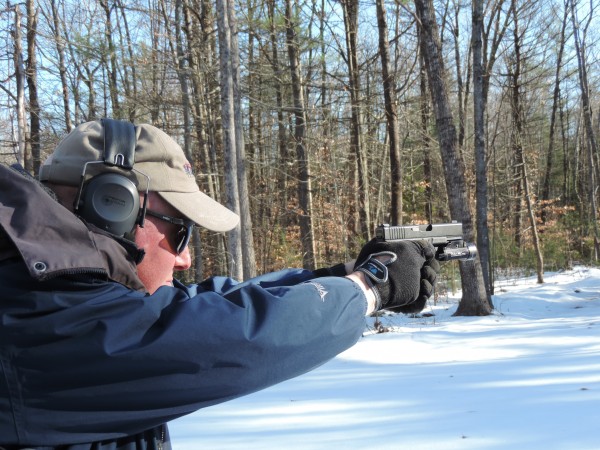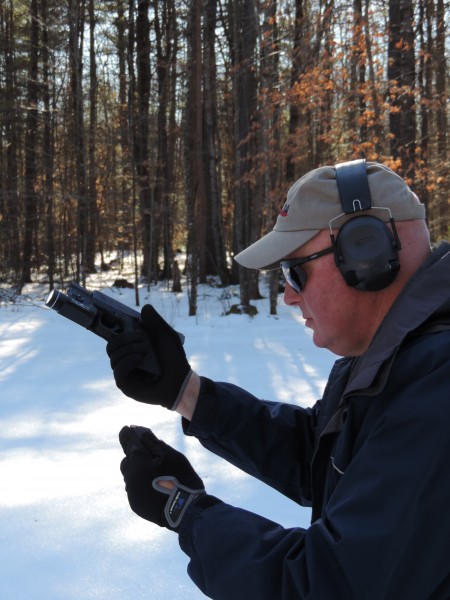For those of us who live in the “Less Temperate” areas of the country. Cold weather training is a reality if you want to keep your training relevant and current. In the Northeast we have approximately 6 months of cold weather and 6 months of not quite as cold weather. There are several differences in cold weather firearms carry and usage that need to be addressed in training.
Heavier garments used for concealment as well as keeping warm bring challenges in drawing your concealed handgun. Are you dealing with one heavy coat or several layers? Is the holstered handgun under a pull over closed front garment and a heavier coat? Will you have to get your hand past an open coat and then pull up a closed front fleece etc. Will you wear your coat open or zipped? How will you access a spare magazine for a reload? How’s that 2 second Tactical Reload affected by your clothing and gloves if you wear them? Your training needs to reflect the methods you use and the clothing you commonly wear.
Will you wear gloves or be bare handed? Will your gloves fit in the trigger guard of your pistol? Will those heavy gloves let you feel the pressure you’re putting on that tuned 3lb. trigger? Or if you’re touching the trigger or in register on the frame or slide? Can you even feel your trigger or fingers? Will those nice warm gloves interfere with your reload by blocking the magazine well of your pistol?
If you wear glasses do they fog or frost over when entering a warm building or vehicle? If they do, can you still see your sights and identify a threat if you need to ditch them in an emergency? Try it on the range before you have to try it in real life.
While not an issue for a handgun worn in concealment in a fast breaking defensive situation, how does the lubricant you use react to extreme cold? Will that wonder lube you used in balmy August thicken and make your AR sluggish or freeze in frigid February, when you’re stuck on containment in a long ongoing situation.
How well do the batteries last in your WML’s and Red Dot Sights in cold weather? Will your optic frost over? If so can you ditch it quickly and switch over and effectively use your iron sights? Will your Optic allow you to see enough to effectively use the dot when it’s coated with Rain or Snow? How bad will the dot bloom when the lens is coated?
These are just some of the issues those of us who operate in extreme cold deal with and need to be aware of. While we get used to it and don’t really think about it, we need to be aware of how it affects us. Make your training realistic and relevant to the conditions that you operate in.
Stay Safe (And Stay Warm)!





Well said. We tend to train in the milder months. Officers need to keep warm but have you seen some of the newer traffic gloves. No way to draw and shoot with those on. Should we practice ripping off the gloves before we draw. It’s -4 right now (just got the kid on the bus) your absolutely right about rifle lube/grease turning and optics frosting over (imagine bailing out of a warmed up cruiser and taking a position in -4, the lens will frost.) Very good read and food for thought.
How will that beautifully crisp new trigger you installed in summer feel when the temp drops and your polymer handgun contracts with the cold?
Hint: it doesn’t break.
Great post.
I’m very lucking I have to worry about getting sweat in my eyes or a slippery grip when my hands get sweaty.
You have to train and wear what your got going to work in. Especially the hot or cold contrition in. You got to know know how it’s going to feel when it’s extremly hot or cold. The guys in the winter climate have it rough.
Jackets can be a safety issue when re holstering . Drawstring or piece of the jacket getting caught in your holster and Triger guard and the trigger goes back and BOOM!
Winter climate guys have it rough. I really look up to you guys.
I think it is essential for people in colder climates to take things mentioned in this article into account. For me I just keep things simple. I don’t wear gloves and I usually just wear a light down jacket. For me it is easier to clear the light jacket then a sweatshirt or multiple layers.